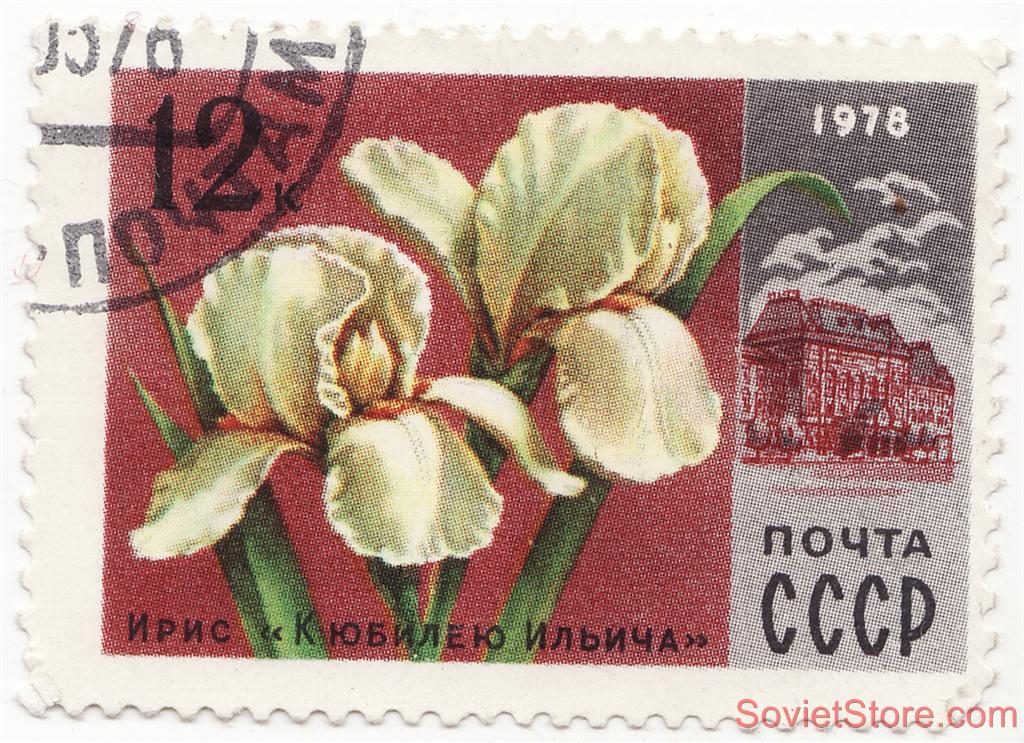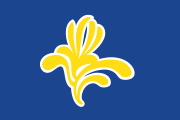SearchProduct Type
|
Add us to: Favorite Stores Item's weight: less then 1 g.
Stamp Authenticity Since 1939 till 1990 Lithuania suffered 3 occupations: 1 German (1941-1944) and 2 Soviet (1939-1941, 1944-1990), one of which lasted 46 years. In WWII occupations were based on violent battles between Germans and Russians. These historical events left a lot of stuff behind them selves. Almost every family in Lithuania has something left, related to USSR history in their forgotten drawers. So we are just traveling around lithuanian countrysides and collecting this memorabilia. Item is original, genuine, authentic, unique, not a copy or replica - has 2-12 decades of it's own unique history.
Iris is a genus of between 200-300 species of flowering plants with showy flowers which takes its name from the Greek word for a rainbow, referring to the wide variety of flower colors found among the many species. As well as being the scientific name, Iris is also very widely used as a common name and refers to all Iris species as well as some closely related genera.The Iris Is the state flower of Tennessee. DescriptionThe genus is widely distributed throughout the north temperate zone. Their habitats are considerably varied, ranging from cold regions into the grassy slopes, meadowlands, stream banks of Europe, the Middle East and northern Africa, Asia and across North America. They are perennial herbs, growing from creeping rhizomes (rhizomatous irises), or, in drier climates, from bulbs (bulbous irises). They have long, erect, flowering stems, which may be simple or branched, solid or hollow, and flattened or have a circular cross-section. The rhizomatous species usually have 3-10 basal, sword-shaped leaves growing in dense clumps. The bulbous species have cylindrical basal leaves. The inflorescences are fan-shaped and contain one or more symmetrical, six-lobed flowers. These grow on a pedicel or lack a footstalk. The three sepals, which are spreading or droop downwards, are referred to as falls. They expand from their narrow base into a broader limb (= expanded portion), often adorned with veining, lines or dots. The three, sometimes reduced, petals stand upright, partly behind the sepal bases. They are called standards. Some smaller iris species have all six lobes pointing straight outwards. The sepals and the petals differ from each other. They are united at their base into a floral tube that lies above the ovary. The styles divide towards the apex into petaloid branches (see pollination, below). The iris flower is of special interest as an example of the relation between flowering plants and pollinating insects. The shape of the flower and the position of the pollen-receiving and stigmatic surfaces on the outer petals form a landing-stage for a flying insect, which in probing the perianth for nectar, will first come in contact of perianth, three with the stigmatic stamens in one whorl surface which is borne and an ovary formed of three carpels. The shelf-like transverse projection on the inner whorl under side of the stamens, which is beneath the over-arching style arm below the stigma, so that the insect comes in contact with its pollen-covered surface only after passing the stigma, while in backing out of the flower it will come in contact only with the non-receptive lower face of the stigma. Thus, an insect bearing pollen from one flower, will in entering a second, deposit the pollen on the stigma, while in backing out of a flower, the pollen which it bears will not be rubbed off on the stigma of the same flower! Classification and taxonomyUp to 300 species have been placed in the genus Iris. Modern classifications, starting with W. R. Dykes' 1913 book, have subdivided them. Dykes referred to the major subgroupings as sections, but later authors have generally called them subgenera, while essentially retaining his groupings. Like some older sources, the influential classification by G. I. Rodionenko removed some groups (particularly the bulbous irises) to separate genera, but even if this is done the genus remains large and several subgenera, sections and/or subsections are recognised within it. There are six subgenera, of which five are restricted to the Old World, and the sixth (subgenus Limniris) with a Holarctic distribution; the two largest subgenera are further divided into sections.
Some authors regard the Snake's Head Iris as lying outside genus Iris, and classify it as Hermodactylus tuberosus. Cultivation
Irises are extensively grown as ornamental plants in gardens. The most commonly found garden iris is the bearded German Iris and its numerous cultivars. Various wild forms and naturally occurring hybrids of Iris pallida and I. variegata form the basis of most all modern hybrid bearded iris. Median forms of bearded iris [intermediate bearded (IB), miniature tall bearded (MTB), etc] are derived from crosses between tall and dwarf varieties. Other iris types commonly found in garden are I. siberica and its hybrids (Siberian irises) and I. ensata and its hybrids (Japanese irises). The bearded irises are easy to cultivate and propagate, and have become very popular in gardens. They grow in any good free garden soil, the smaller and more delicate species needing only the aid of turf ingredients, either peat or loam, to keep it light and open in texture. The earliest to bloom are the dwarf forms of Iris pumila, which blossom during March, April and May; and during the latter month and the following one most of the larger growing 'tall bearded' varieties, such as I. germanica, florentina, pallida, variegata, amoena, flavescens, sambucina, neglecta, ruthenica and their modern hybrids. A true red standard, tall bearded Iris remains an unattained goal of frequent hybridizing and selection. There are species and selections thereof, most notably Iris fulva, which has a relatively pure red color. However, getting this color into a modern Iris breed has proven very difficult, and thus, the vast majority of Irises are in the purple and blue range of the color spectrum. The section Iris subgen. Iris sect. Oncocyclus contains the cushion or royal irises, a group of plants noted for their large, strongly marked flowers. Between 30 and 60 species are classified in this section, depending on the authority. Compared with other irises the cushion varieties are scantily furnished with narrow sickle shaped leaves and the flowers are usually borne singly on the stalks. The closely allied Iris subgenus Iris sect. Regelia, includes several garden hybrids with species in sect. Oncocyclus, known as "Regelio-cyclus" irises. They are best planted in September or October in warm sunny positions, the rhizomes being lifted the following July after the leaves have withered. Iris unguicularis (syn. I. stylosa) is a late-winter-flowering species from Algeria, with sky-blue flowers blotched with yellow, produced (in the Northern Hemisphere) from November to March or April. Japanese iris (Hanashobu, Iris ensata var. ensata, syn. I. ensata var. hortensis、I. kaempferi) is extensively cultivated in Japanese gardens. Many other smaller species of bulbous iris, being liable to perish from excess of moisture, should have a well-drained bed of good but porous soil made up for them, in some sunny spot, and in winter should be protected by a covering of half-decayed leaves or fresh coco-fibre refuse. To this set belong I. milifolia, I. junonia, I. danfordiae, I. reichenbachii and others which flower as early as February and March. The cushion irises are somewhat fastidious growers, and to be successful with them they must be planted rather shallow in very gritty well-drained soil. They should not be disturbed in the autumn, and after the leaves have withered the roots should be protected from heavy rains until growth starts again naturally.
UsesRhizomes of the bearded iris are the source of orris root and are used in perfume, and medicine, though more common in ancient times than today. Today Iris essential oil (absolute) from flowers are sometimes used in Aromatherapy as sedative medicines. Iris pseudoacorus is also used in water purification. The dried rhizomes are also given whole to babies to help in teething. Magellan Gin uses iris root and flower, for flavor and color. Iris rhizomes contain terpenes, organic acids (miristic acid, undecilene acid, tridecilic acid), glycosides, and iridin, and the leaves contain ascorbic acid. PerfumeryIris rhizomes are harvested, dried, and aged for up to 5 years. In this time, the fats and oils inside the roots undergo degradation and oxidation, which produces many fragrant compounds that are valuable in perfumery. The scent is said to be similar to violets. The aged rhizomes are steam distilled which produces a thick oily compound, known in the perfume industry as iris butter. ArtThe artist George Gessert has specialised in breeding irises.[2] The artist Vincent van Gogh painted several famous pictures of irises. [3] The artist Philip Hermogenes Calderon painted an iris in Broken Vows (1856). He followed the principles of the Pre-Raphaelite Brotherhood. An ancient belief is that the iris serves as a warning to be heeded, as it was named for the messenger of Olympus. It also conveys images of lost love and silent grief, for young girls were led into the afterlife by Iris. Broken Vows was accompanied with poetry by Henry Wadsworth Longfellow when it was first exhibited. Water purification
In water purification, Iris pseudoacorus is used. The roots are usually planted in a substrate (eg lava-stone) in a reedbed-setup). The roots then filter the water by consuming nutrients within the water.
Symbolism
The fleur-de-lis, a stylized iris, descends from the white iris which is native to Florence, Italy and which grew even in its city walls. This white iris, displayed against a red background, became the symbol of Florence until the Medici family, to signal a change in political power, reversed the colors making the white one red and setting in motion a centuries-long breeding program to hybridize a red iris. Catherine de Medici carried this symbol of Florence to Paris when she married the king of France where this most famous of irises acquired its moniker, fleur-de-lis. Contemporary uses can be seen in the Quebec flag and the logo of the New Orleans Saints professional football team, and on the flag of Saint Louis, Missouri. The iris has been associated with France as Louis VII adopted it as a symbol in the 12th Century. Furthermore, it is also the almost universal symbol of Scouting. In addition, it is one of the symbols adopted by the sorority, Kappa Kappa Gamma. The iris is the symbol of Brussels, since historically, the important Saint Gaugericus Island was carpeted in them.[1] The iris is now the sole feature on the flag of the Brussels-Capital Region. References
The free listing tool. List your items fast and easy and manage your active items. On Jul-05-08 at 09:42:42 PDT, seller added the following information:
| Return
Items must be returned within 30 days .
Refund will be given as Money back. Refund policy details: Return is accepted at any reason. Item(s) must arrive to us not later then 30 days after it was shipped out (you will be informed about this immediately after it will be done). Returned items must be the same item in the exact same condition as originally shipped. Refunds are for the final eBay item purchase price only, less a 10% restocking fee. Shipping costs, insurance, and handling charges (if any) are non refundable. Returns must be shipped insured. Shipping
Payment Method
Insurance
Not Offered (Domestic)
|
Shopping Cart |
||||||||||||||||||||||||||||||||||||||||||||||||||||||||||||||||||||||||||||||||||||||
















